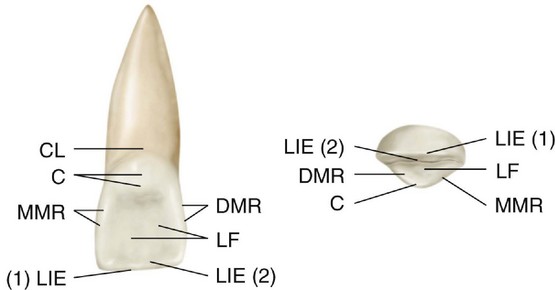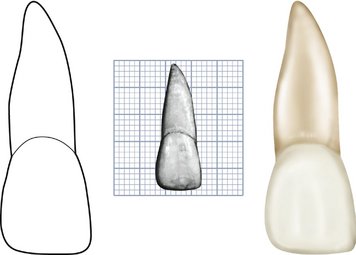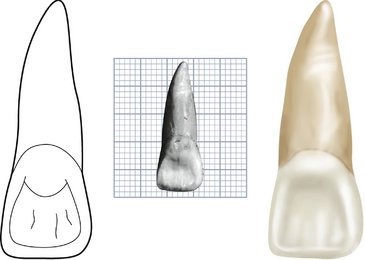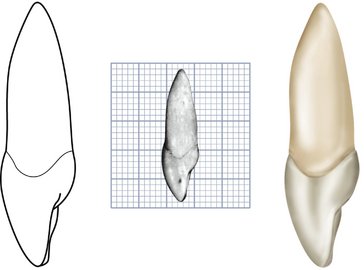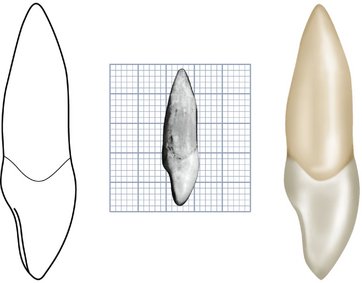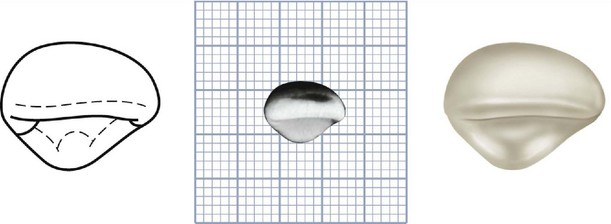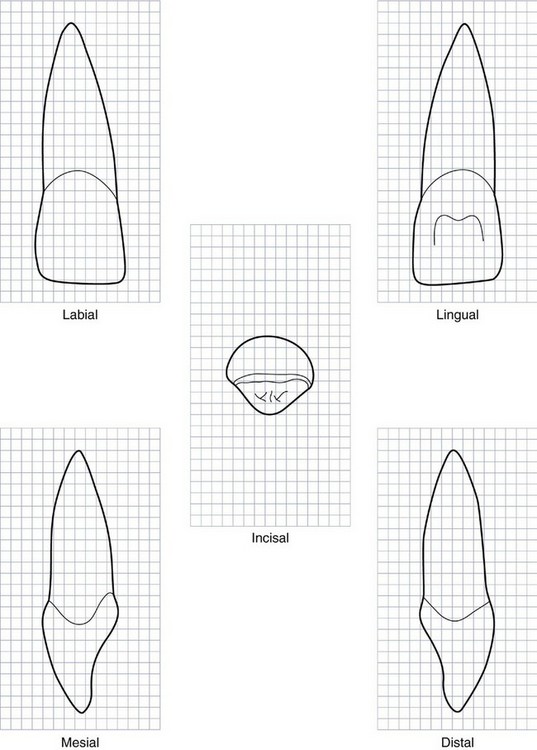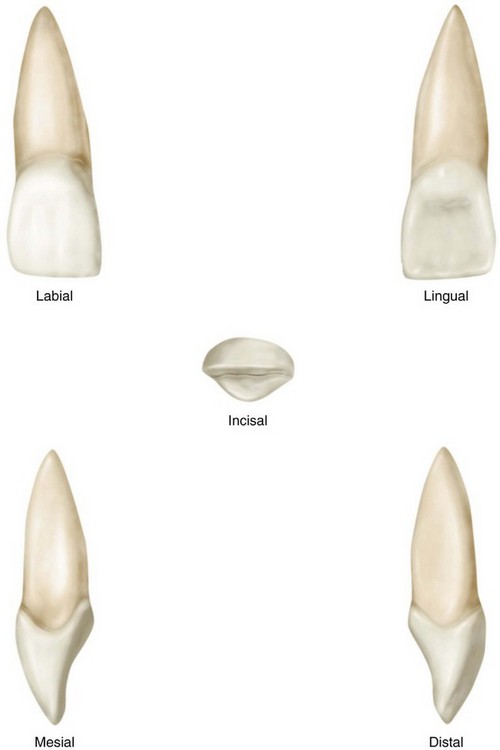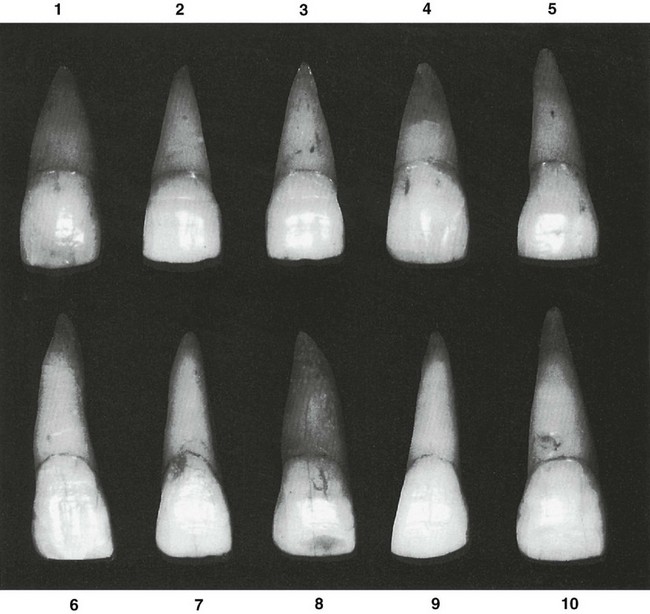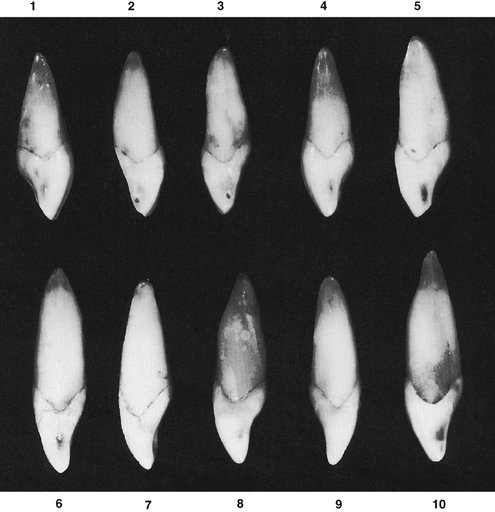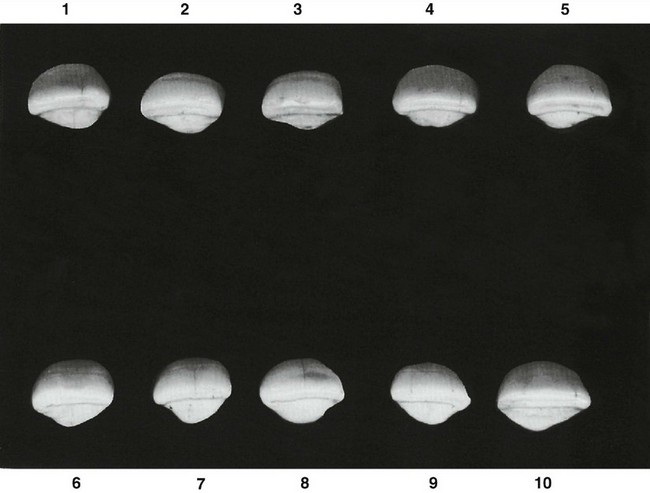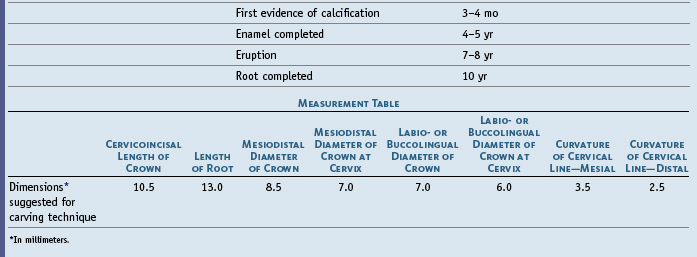6 The Permanent Maxillary Incisors
It might be good at this point to differentiate between the two terms incisal ridge and incisal edge. The incisal ridge is that portion of the crown which makes up the complete incisal portion. When an incisor is newly erupted, the incisal portion is rounded and merges with the mesioincisal and distoincisal angles and the labial and lingual surfaces. This ridge portion of the crown is called the incisal ridge. The term edge implies an angle formed by the merging of two flat surfaces. Therefore, an incisal edge does not exist on an incisor until occlusal wear has created a flattened surface linguoincisally, which surface forms an angle with the labial surface. The incisal edge is formed by the junction of the linguoincisal surface, sometimes called the incisal surface, and the labial surface (Figure 6-1).
Preceding the description of each tooth in this and subsequent chapters, the chronology of calcification and eruption of each tooth will be given as taken from Table 2-2. Knowing the proportions of the individual tooth helps one learn the proportions of one tooth to another. Outline drawings of the five aspects of the teeth are explained more fully elsewhere.1
Maxillary Central Incisor
Figures 6-1 through 6-12 illustrate the maxillary central incisor in various aspects. The maxillary central incisor is the widest mesiodistally of any of the anterior teeth (Table 6-1). The labial face is less convex than that of the maxillary lateral incisor or canine, which gives the central incisor a squared or rectangular appearance (see Figures 6-7 and 6-8). From this aspect, the crown nearly always looks symmetrical and regularly formed, having a nearly straight incisal edge, a cervical line with even curvature toward the root, a mesial side with straight outline, the distal side being more curved. The mesial incisal angle is relatively sharp, the distal incisal angle rounded (see Figure 6-2).
Although the labial surface of the crown is usually convex, especially toward the cervical third, some central incisors are flat at the middle and incisal portions. The enamel surface is relatively smooth. When the tooth is newly erupted or if little wear is evident, mamelons will be seen on the incisal ridge. The middle one is the smallest. The developmental lines on the labial surface that divide the surface into three parts are most noticeable at the middle portion if they can be distinguished at all (see Figure 2-12).
Lingually, the surface form of the maxillary central incisor is more irregular. The largest part of the middle and incisal portions of the lingual area is concave. Mesial and distal marginal ridges border the concavity, the lingual portion of the incisal ridge, and the convexity apically to the cingulum. The lingual topography gives a scooplike form to the crown (see Figure 6-3). An exaggeration of the marginal ridges, known as a shovel-shaped incisor, is a genetically determined variation seen in Mongoloid races, including North and South American Indians.2–4
The maxillary central incisor usually develops normally. One anomaly that sometimes occurs is a short root. Another variation is an unusually long crown (see Figure 6-12, 4 and 5). The maxillary central incisors are the most prominent teeth in the mouth. There are two basic forms: the first is relatively wide at the cervix, when viewed from the labial aspect, in comparison with the mesiodistal width at the contact areas (see Figure 6-9, 1 and 4); the second form is relatively narrow at the cervix, where the root joins the crown, in comparison with the mesiodistal width at the contact areas (see Figure 6-9, 5, 7, and 9).
In the description of the central incisor, an attempt will be made to strike an average between the extremes of the two forms, keeping in mind that crown sizes are gender dimorphic, with male larger than female. The extent of dimorphism varies among populations.5 However, gender-specific correlations between enamel thickness and crown width of dentin are low.6
DETAILED DESCRIPTION OF THE MAXILLARY CENTRAL INCISOR FROM ALL ASPECTS
Labial Aspect
The crown of the average central incisor will be 10 to 11 mm long from the highest point on the cervical line to the lowest point on the incisal edge (see Figures 6-2 and 6-9). The mesiodistal measurement will be 8 to 9 mm wide at the contact areas. The mesiodistal measurement, where the root joins the crown, will be 1.5 to 2 mm less. The crests of curvature mesially and distally on the crown represent the areas at which the central incisor contacts its neighbors. Any change in the position of this crest of contour affects the level of the contact area (see Figure 5-15, A).
The mesial outline of the crown is only slightly convex, with the crest of curvature (representing the contact area) approaching the mesioincisal angle (see Chapter 5).
Stay updated, free dental videos. Join our Telegram channel

VIDEdental - Online dental courses


